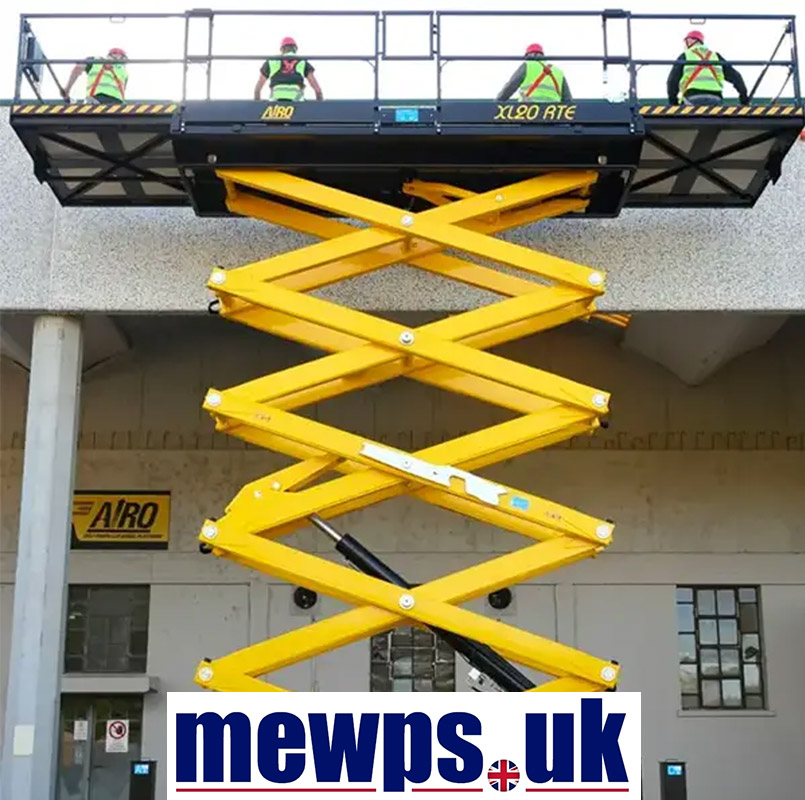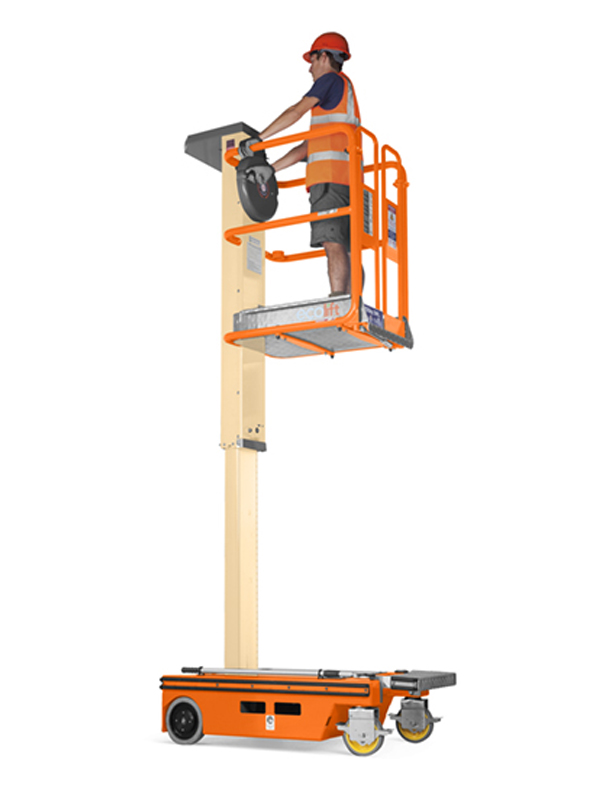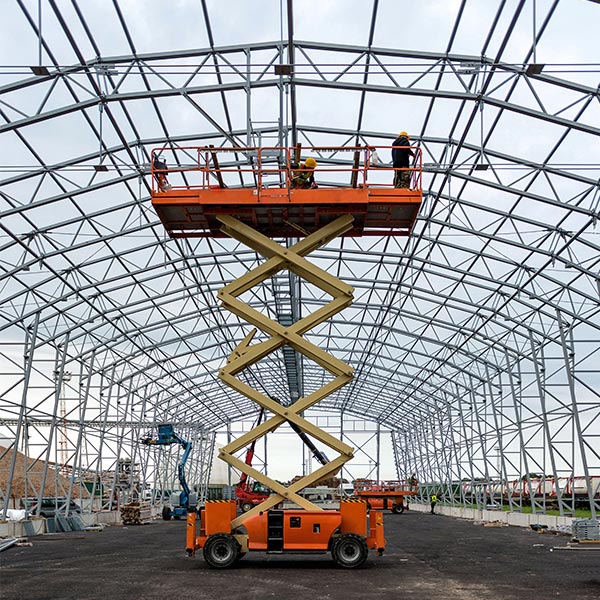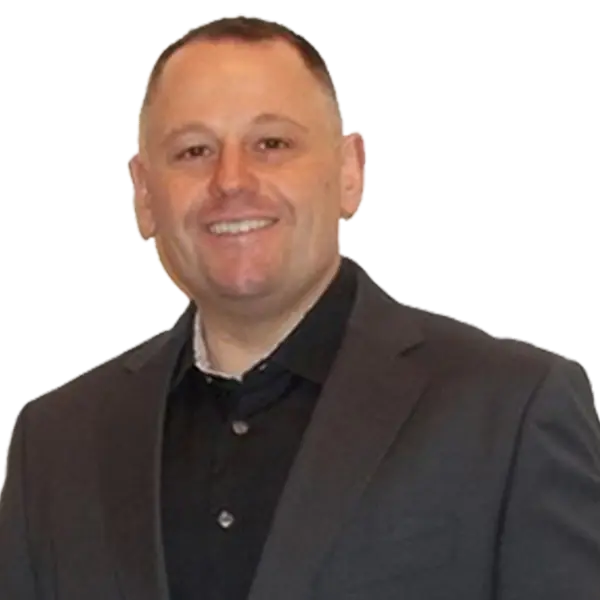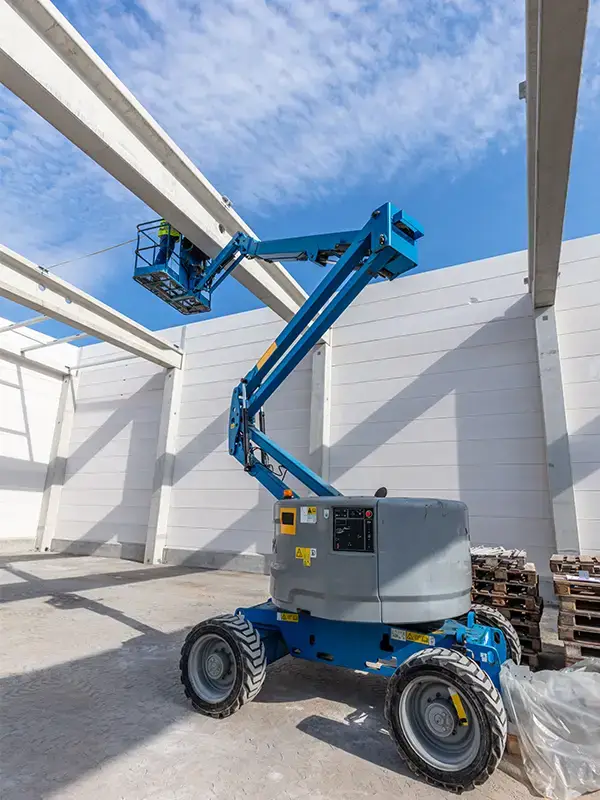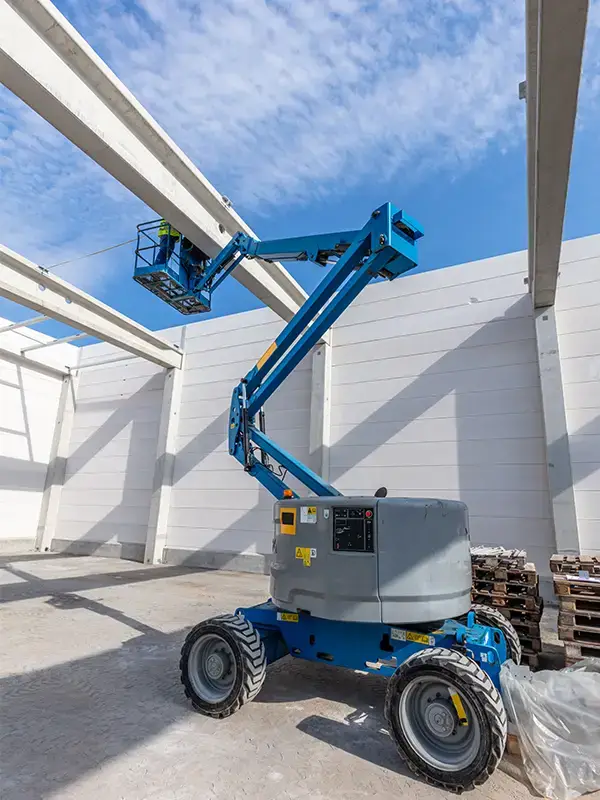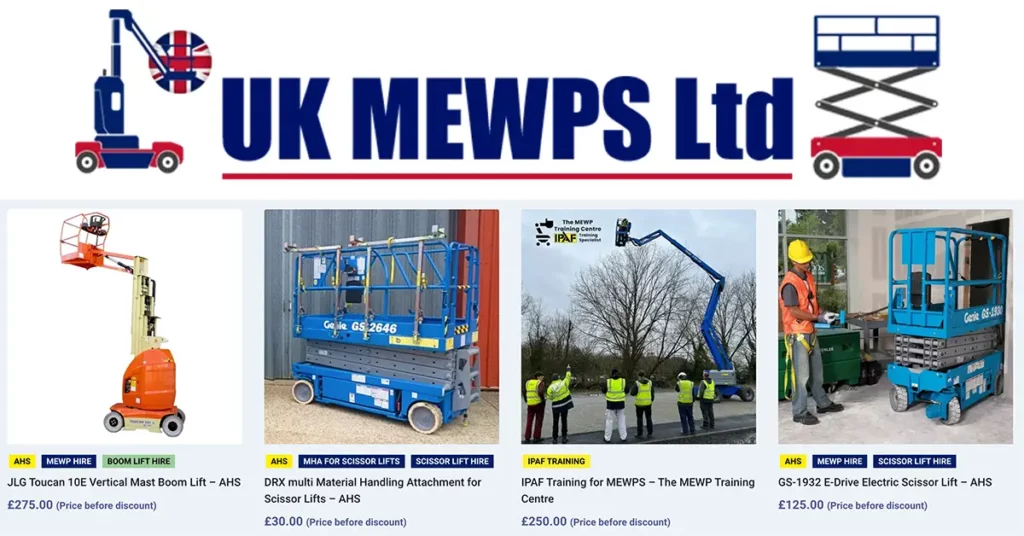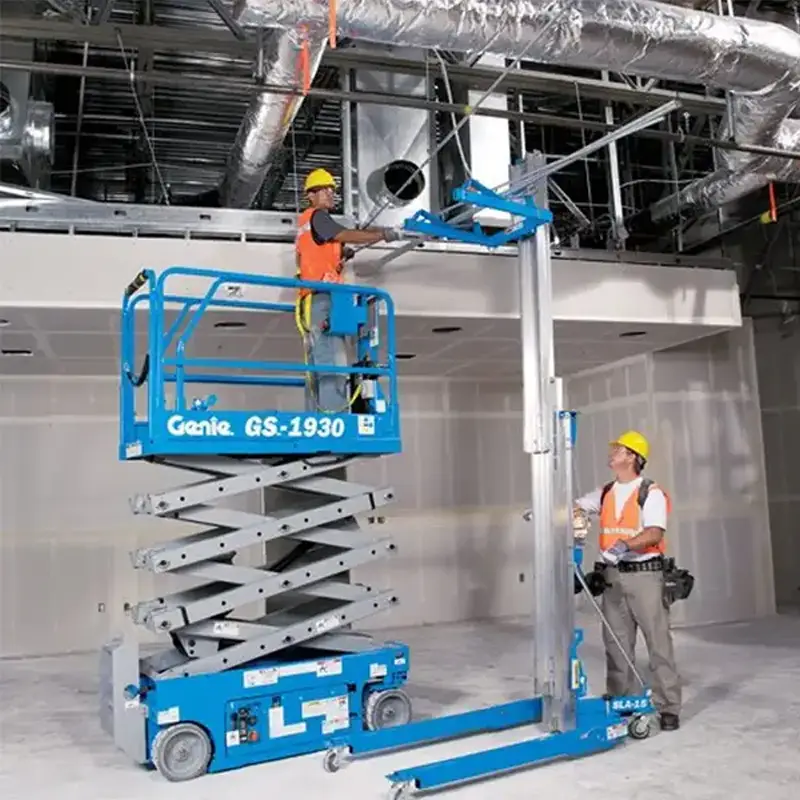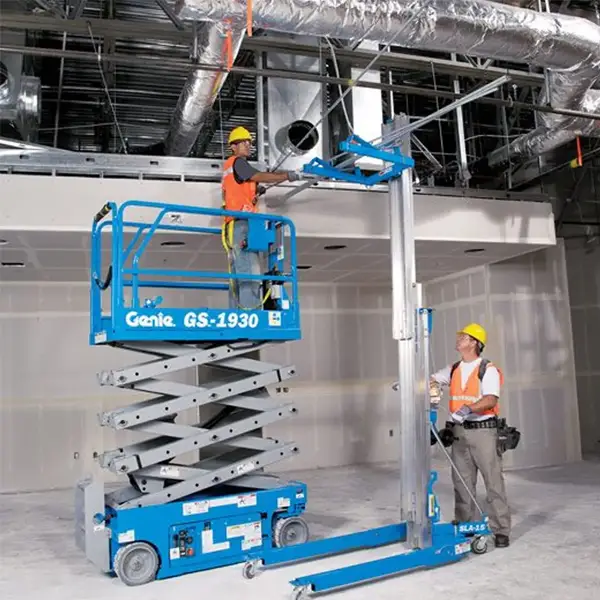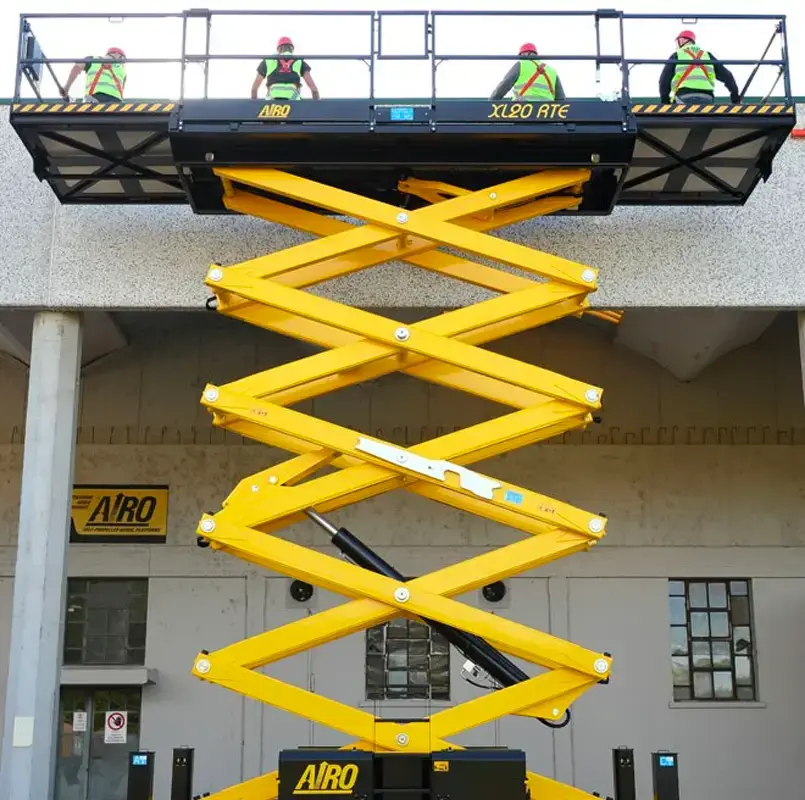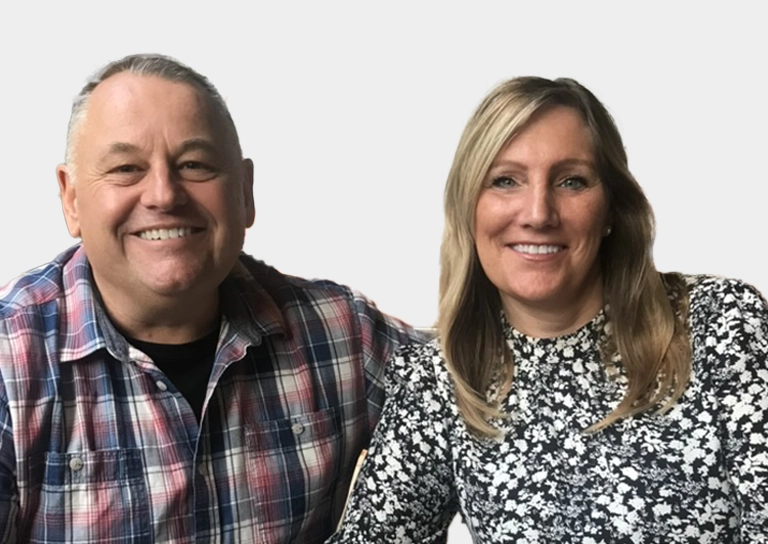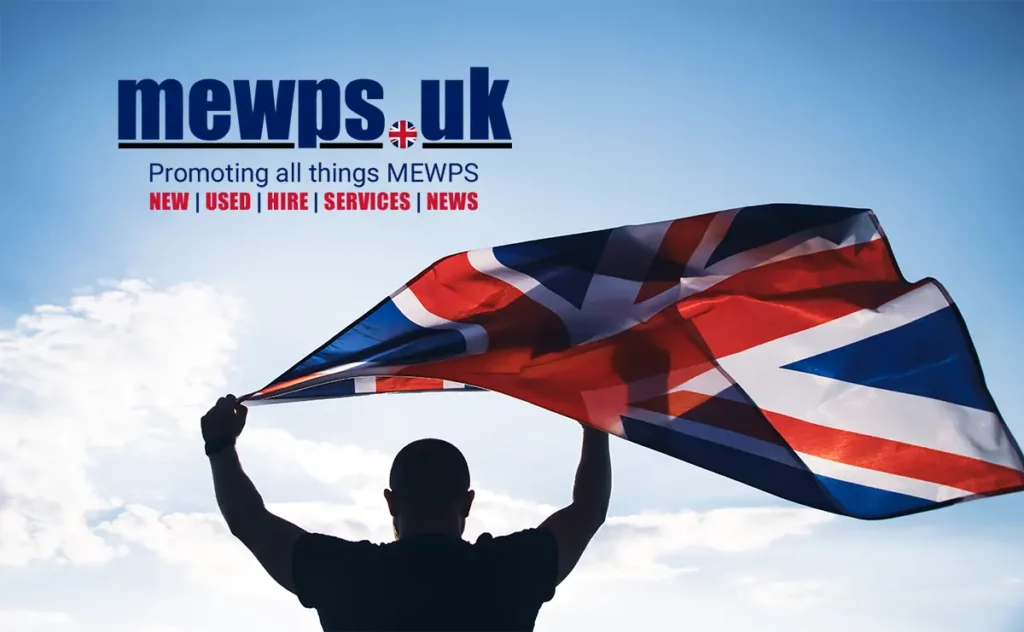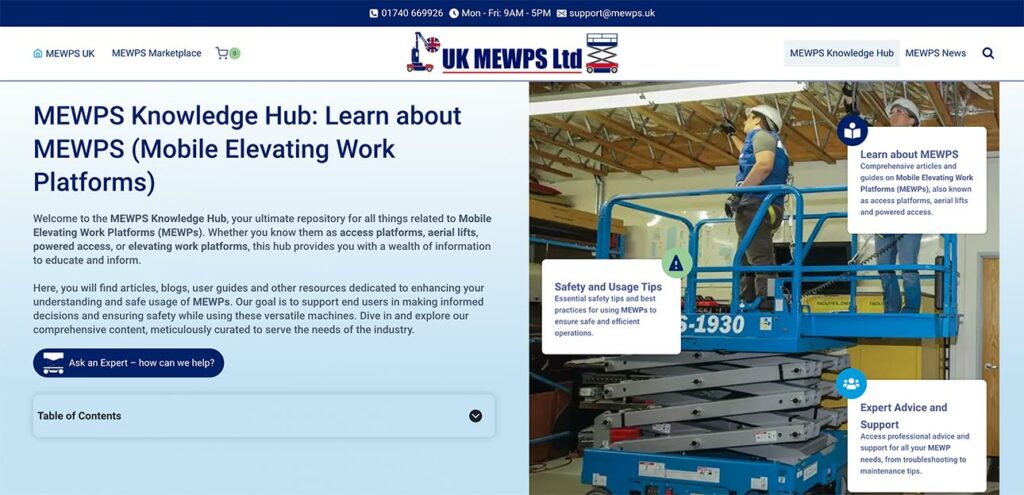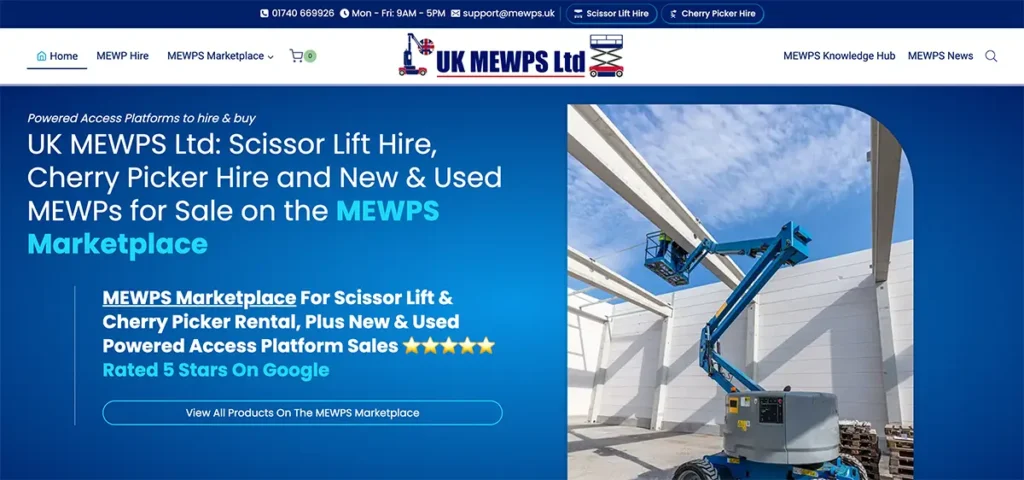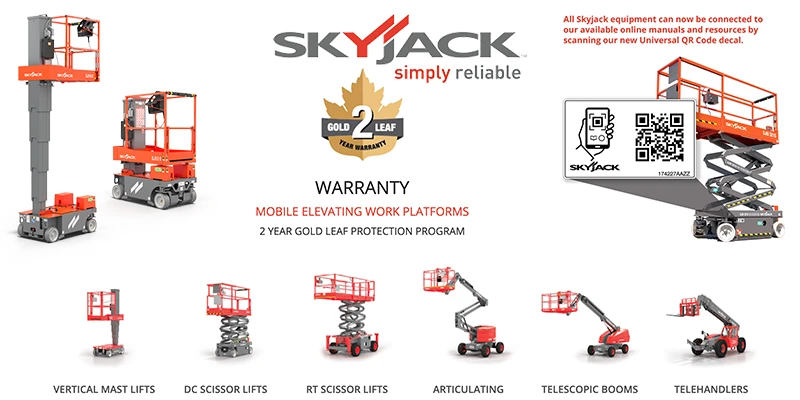Comprehensive Guide to Mobile Elevating Work Platforms (MEWPs) in the UK
Explore everything you need to know about Mobile Elevating Work Platforms (MEWPs), also known as aerial work platforms (AWPs), aerial lifts, or cherry pickers. From understanding the various types of MEWPs, such as scissor lifts and boom lifts, spider lifts and towable trailer-mounted booms, to their critical applications in sectors such as construction, facilities management (FM), mechanical engineering, warehousing and entertainment, this guide covers it all.
Stay informed on essential safety practices, legal regulations and the latest technological innovations that ensure safe and efficient operations at height, providing temporary access to otherwise inaccessible areas.
Hire BOOM LIFTS
hire services in UK
Rent MEWPS
scissor lift rental
Next day DELIVERY
next day delivery available
Introduction to Mobile Elevating Work Platforms (MEWPs)
A Mobile Elevating Work Platform (MEWP) is a mechanical device designed to provide temporary access to areas that are difficult to reach, typically at height. These powered access platforms are essential tools in industries like construction, facilities management (FM), mechanical engineering, lighting, rail, maintenance, and warehousing, allowing workers to perform tasks safely at elevated levels.
Types of MEWPs
MEWPs come in various types, each suited to different tasks and environments. The most common types include scissor lifts, boom lifts (cherry pickers), spider lifts, van mounted booms, truck mounted booms, low-level access and push-around vertical lifts. Each type has its own set of features, making them suitable for specific applications such as narrow access points, rough terrains, or high reach requirements.
Applications of MEWPs
MEWPs are versatile machines used across multiple industries. They are vital in construction for tasks like steel frame erection, netting, cladding, installing windows or roofing. In warehousing, they facilitate inventory management and equipment maintenance. They also play a crucial role in event setups, tree surgery and even the film industry, where they help in setting up lights and cameras at various angles. The MEWPS Marketplace for rental and hire of MEWP equipment, plus sales of new access platforms and used powered access equipment in the UK, is a vibrant community where leading equipment rental companies and manufacturers (OEM – Original Equipment Manufacturer) all compete for UK market share of ever-varying MEWPs application.
Safety and Regulations
Safety is paramount when operating MEWPs. These machines are equipped with numerous safety features, such as fall protection systems, stability controls and emergency descent functions. Operators must be trained and certified and the equipment must comply with regulations such as OSHA in the US, PUWER and LOLER in the UK.
Importance of MEWPs in Modern Industry
MEWPs have revolutionised how work is conducted at height. By providing a safe, efficient and versatile platform for elevated work, they reduce the need for scaffolding, ladders and other traditional methods that are often less safe and more time-consuming.
Technological Innovations in MEWPs
The evolution of MEWPs knowledge continues with advancements in automation, hybrid models, and smart features. These innovations improve safety, efficiency and environmental impact, making MEWPs more reliable and easier to use in a variety of settings. MEWPs news keeps us up to date on how the access industry is adapting and innovating.
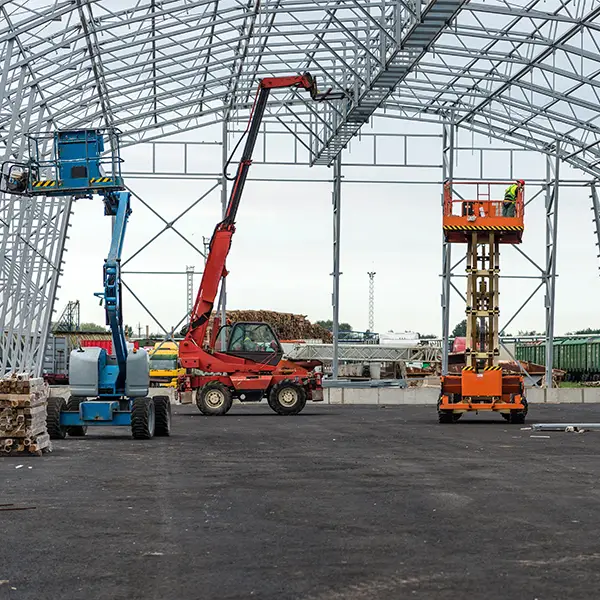
MEWPS Knowledge: People ask us…
Types of Mobile Elevating Work Platforms (MEWPs)
Scissor Lifts
Scissor lifts are the most common type of MEWP, characterised by their criss-cross (scissor) mechanism that extends vertically. They are ideal for tasks that require vertical access with a stable platform, such as indoor maintenance, painting and installation work.
Key Features:
- Vertical lift movement.
- High load capacity.
- Electric or diesel-powered options.
Common Uses:
- Indoor maintenance.
- Warehouse operations.
- Electrical work.
Boom Lifts (Cherry Pickers)
Boom lifts are highly versatile MEWPs that feature an extendable arm (boom) that can reach both vertically and horizontally. This type includes articulating boom lifts, which have multiple sections that bend, allowing access over obstacles and telescopic boom lifts, which have a straight arm that extends for maximum reach.
Key Features:
- Horizontal and vertical reach.
- Articulating and telescopic versions.
- Suitable for uneven terrain.
Common Uses:
- Outdoor construction.
- Tree trimming.
- Electrical line work.

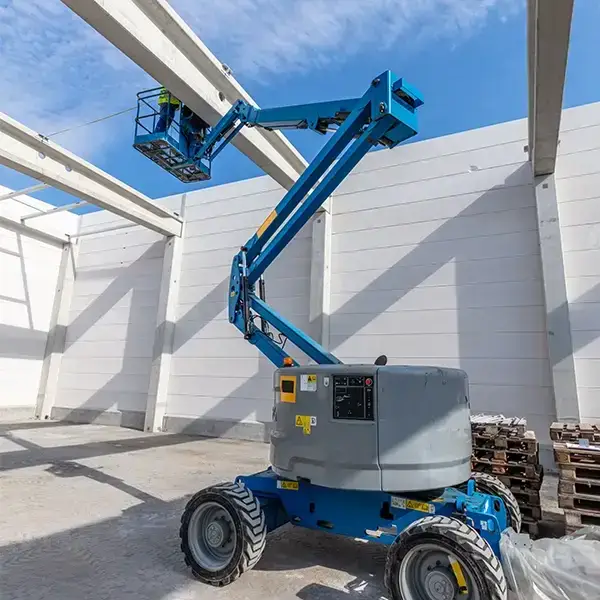
Spider Lifts
Spider lifts are compact and versatile, designed for use in confined spaces or rough terrain. They have extendable legs (hence the name “spider”) that provide stability on uneven surfaces. These lifts are often used in areas where traditional MEWPs cannot operate, such as in forestry or indoor areas with tight access.
Key Features:
- Compact and lightweight.
- Multi-terrain capability.
- Stabilising legs for rough ground.
Common Uses:
- Forestry.
- Narrow indoor spaces.
- Event setup.
Push Around Vertical Lifts (PAVs)
Push Around Vertical Lifts are small, manually operated MEWPs that are easy to move and position. They are ideal for low-level access tasks where space is limited. PAVs are commonly used in indoor settings for tasks such as changing light bulbs, reaching high shelves, or performing routine maintenance.
Key Features:
- Portable and easy to manoeuvre.
- Low-level access.
- Manual positioning.
Common Uses:
- Indoor maintenance.
- Retail stocking.
- Low-level construction.
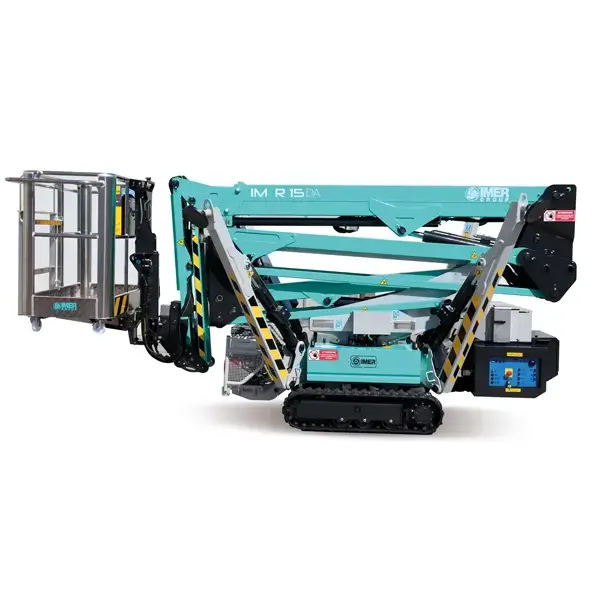
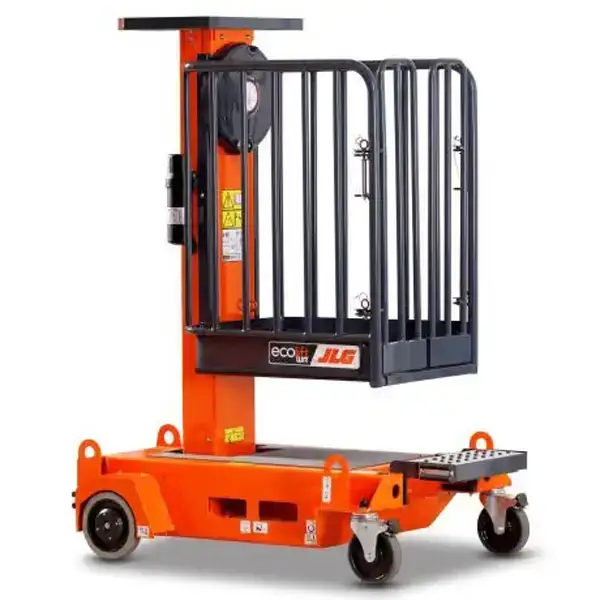
Telehandlers
Telehandlers are a hybrid between a forklift and a crane, featuring a telescopic boom that can lift materials to high places. They are highly versatile and can be equipped with various attachments, making them suitable for a wide range of tasks beyond just lifting, such as moving heavy loads or positioning materials.
Key Features:
- Telescopic boom.
- Versatile attachments.
- High lifting capacity.
Common Uses:
- Construction.
- Agriculture.
- Heavy material handling.
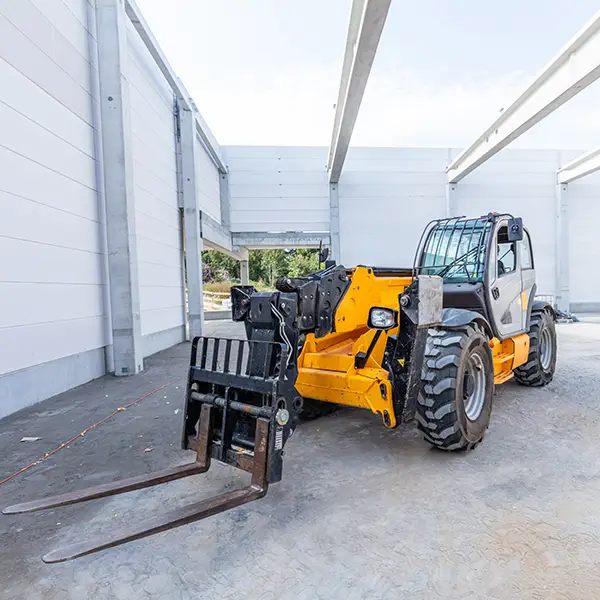
Applications of Mobile Elevating Work Platforms (MEWPs)
Construction
MEWPs are indispensable in the construction industry, providing safe and efficient access to elevated work areas. They are used for tasks such as installing windows, roofing and other finishing tasks that require precision at height.
Key Applications:
- Window Installation: Precise placement and securement of windows at various building heights.
- Roofing: Safe access to rooftops for installation, maintenance and repairs.
- Painting and Finishing: Reaching high walls and ceilings for painting, plastering and other finishing work.
Benefits:
- Reduces the time and labour needed for tasks compared to traditional methods.
- Enhances safety by providing a stable platform and reducing the need for manual handling at height.
- Increases productivity with the ability to reposition quickly and easily.
Warehousing and Logistics
In warehousing and logistics, MEWPs are used for inventory management, equipment maintenance and other tasks that require vertical access. They allow workers to reach high shelves safely and efficiently, ensuring that operations run smoothly without the risk associated with climbing ladders or using forklifts inappropriately.
Key Applications:
- Inventory Management: Accessing high shelves to place or retrieve items.
- Equipment Maintenance: Performing maintenance tasks on high equipment, such as conveyor belts or lighting fixtures.
- Stocktaking: Efficiently scanning and counting items located at height.
Benefits:
- Improves safety by reducing the need for manual lifting and climbing.
- Enhances operational efficiency by allowing quick access to high areas.
- Versatility in narrow aisles and confined spaces.
Exhibitions and Events
MEWPs play a critical role in setting up exhibitions and events, especially for tasks like building stages, hanging banners and installing lighting. These platforms allow event organisers to set up large installations safely and efficiently, often in a fraction of the time it would take with scaffolding.
Key Applications:
- Stage Construction: Safe access to build and dismantle stages and backdrops.
- Lighting and Sound Installation: Precise positioning of lighting rigs and speakers.
- Banner and Signage Hanging: Installing promotional materials at significant heights.
Benefits:
- Ensures that setups are completed on time and within budget.
- Enhances safety by providing stable platforms in crowded or confined areas.
- Flexibility to adapt to different venue sizes and configurations.
Film and Entertainment
In the film and entertainment industry, MEWPs are essential for setting up complex stage designs, positioning lights and achieving unique camera angles. They provide the flexibility and safety needed to create dynamic shots and secure heavy equipment at height.
Key Applications:
- Lighting Setup: Positioning lights at various heights and angles to achieve desired effects.
- Camera Positioning: Gaining unique camera angles and shots from elevated positions.
- Stage and Set Construction: Safely assembling and disassembling sets and props.
Benefits:
- Increases creative possibilities by enabling access to otherwise hard-to-reach areas.
- Improves safety for crew members working at height.
- Enhances efficiency, reducing the time required for setup and takedown.
Signage Installation
MEWPs are widely used for the installation and maintenance of signage, especially in high, hard-to-reach locations. Whether it’s a small business sign or a large billboard, MEWPs provide the necessary reach and stability to ensure the job is done safely and accurately.
Key Applications:
- Billboard Installation: Safe positioning and securing of large signs at height.
- Retail Signage: Installing and maintaining signs for storefronts and shopping centres.
- Public Signage: Erecting directional and informational signs in public spaces.
Benefits:
- Provides a stable platform for precise work, reducing the risk of errors.
- Enhances safety for workers installing heavy and large signs.
- Flexibility in positioning signs in challenging locations.
Tree Surgery and Landscaping
In tree surgery and landscaping, MEWPs are used to safely trim trees, remove high branches and perform other landscaping tasks that require working at height. These platforms are particularly useful in residential areas where space is limited and precision is required to avoid damage to property.
Key Applications:
- Tree Trimming: Safely accessing and trimming high branches.
- Tree Removal: Providing a stable platform for cutting down trees in sections.
- Landscape Maintenance: Reaching elevated areas for pruning or hedge trimming.
Benefits:
- Increases safety by reducing the need for climbing and manual cutting.
- Enhances precision, allowing for detailed work in confined spaces.
- Reduces time and labour required for large-scale landscaping projects.
Safety and Risk Management
Risk Assessment
Conducting a risk assessment is a critical first step before operating any MEWP. This process involves identifying potential hazards, such as unstable ground, overhead obstacles and weather conditions, and implementing control measures to mitigate these risks.
Key Considerations:
- Site Conditions: Assessing the stability of the ground, presence of slopes and potential obstacles.
- Weather Conditions: Evaluating the impact of wind, rain, or extreme temperatures on MEWP operation.
- Operator Training: Ensuring operators are adequately trained and aware of potential risks.
Risk Mitigation Strategies:
- Implementing traffic management plans to separate MEWPs from other vehicles and pedestrians.
- Using ground mats or stabilisers to ensure platform stability on uneven terrain.
- Scheduling operations during favourable weather conditions to minimise risk.
Safety Features
Modern MEWPs are equipped with a range of safety features designed to protect operators and reduce the risk of accidents. These features include fall protection systems, anti-entrapment devices and stability controls.
Key Safety Features:
- Fall Protection: Harnesses, guardrails, and anchor points to prevent falls.
- Stability Controls: Outriggers, automatic levelling systems and tilt sensors.
- Anti-Entrapment Devices: Systems that detect and prevent crushing incidents.
Importance:
- These features significantly reduce the likelihood of accidents, making MEWPs safer to use.
- They help comply with legal safety standards and regulations, reducing liability for employers.
- Enhances operator confidence, leading to more efficient and focused work.
Accident Prevention
Preventing accidents when using MEWPs involves a combination of proper training, adherence to safety protocols and regular equipment maintenance. Common accidents include falls from height, entrapment and equipment tipping over.
Best Practices:
- Training: Ensuring all operators are certified and understand the specific risks associated with MEWPs.
- Maintenance: Conducting regular inspections and servicing to ensure equipment is in optimal condition.
- Supervision: Having a competent person oversee MEWP operations to enforce safety protocols.
Common Accidents and Prevention:
- Falls from Height: Use of harnesses and guardrails, proper operator training.
- Entrapment: Implementing anti-entrapment devices and maintaining awareness of surroundings.
- Tip-Overs: Ensuring stable ground conditions and using outriggers or stabilisers.
Legal Regulations
Operating MEWPs requires compliance with various legal standards and regulations designed to ensure safety. In the UK, these include PUWER (Provision and Use of Work Equipment Regulations) and LOLER (Lifting Operations and Lifting Equipment Regulations), while OSHA standards apply in the US.
Key Regulations:
- PUWER: Ensures that work equipment is suitable for use, maintained and inspected regularly.
- LOLER: Covers lifting operations, ensuring they are properly planned, supervised and executed.
- OSHA: US regulations focusing on workplace safety, including specific standards for MEWPs.
Compliance Strategies:
- Regularly reviewing and updating safety procedures to comply with the latest regulations.
- Keeping detailed records of inspections, maintenance and operator certifications.
- Providing ongoing training to ensure that all staff are aware of their responsibilities under these regulations.
Training and Certification
Training and Certification
Proper certification is mandatory for anyone operating a MEWP. Certification programs ensure that operators have the necessary knowledge and skills to use the equipment safely and effectively.
Certification Programs:
- IPAF Certification: Recognised globally, the International Powered Access Federation offers comprehensive training for MEWP operators.
- CPCS: The Construction Plant Competence Scheme in the UK provides another pathway for certification.
- OSHA Certification: In the US, operators must complete training that complies with OSHA standards.
Process:
- Initial Training: Covers the basics of MEWP operation, safety protocols and legal requirements.
- Practical Assessment: Hands-on testing to ensure operators can safely handle the equipment in various scenarios.
- Re-certification: Regular refresher courses to maintain and update skills.
Training Programs
In addition to certification, ongoing training programs help operators stay up-to-date with the latest safety practices, technological advancements and regulatory changes.
Key Training Providers:
- IPAF (International Powered Access Federation): Offers comprehensive training courses for various types of MEWPs, including scissor lifts, boom lifts and more. IPAF’s PAL (Powered Access Licence) is globally recognised and is a standard requirement for MEWP operators.
- CPCS (Construction Plant Competence Scheme): This UK-based scheme offers training and certification for a wide range of construction equipment, including MEWPs. CPCS provides a certification card that is a requirement on many construction sites.
- OSHA Compliance Training: In the United States, OSHA mandates training for workers operating MEWPs, covering topics such as fall protection, hazard identification and emergency procedures. This training ensures compliance with federal safety standards.
Training Content:
- Basic Operator Training: Includes understanding MEWP controls, safe operating procedures and emergency lowering techniques.
- Advanced Training: Focuses on more complex operations, such as working on inclines, using MEWPs in confined spaces and operating under adverse weather conditions.
- Safety Refresher Courses: Regularly scheduled courses to keep operators updated on the latest safety protocols and regulatory changes.
Benefits of Training:
- Reduces the risk of accidents by ensuring operators are knowledgeable and competent.
- Enhances operational efficiency as trained operators can handle equipment more effectively.
- Ensures compliance with legal requirements, reducing the risk of fines and legal issues.
Maintenance and Inspection
Regular maintenance and inspection of MEWPs are critical for ensuring the safety and longevity of the equipment. This includes routine checks, servicing and repairs to prevent mechanical failures and accidents.
Routine Checks:
- Pre-Operational Inspections: Daily checks before the use of MEWPs, including inspecting the control systems, hydraulic fluid levels and tyres.
- Safety Systems Check: Verifying that all safety mechanisms, such as guardrails, harness attachment points and anti-entrapment devices, are functioning correctly.
Scheduled Maintenance:
- Manufacturer-Recommended Servicing: Following the maintenance schedule recommended by the equipment manufacturer, which typically includes detailed inspections and servicing after a certain number of operational hours.
- Component Replacement: Replacing worn or damaged parts, such as hydraulic seals, to prevent unexpected breakdowns.
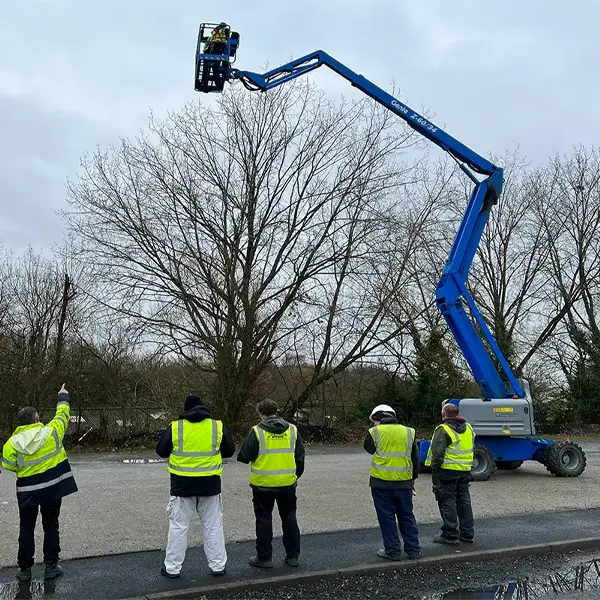
Technological Innovations
Automation
Automation is revolutionising the MEWP industry by introducing features that enhance safety and operational efficiency. Automated systems can assist in tasks like stabilising the platform, adjusting the height and even navigating around obstacles.
Key Features:
- Automated Stability Control: Systems that automatically adjust the platform to maintain balance on uneven ground.
- Collision Avoidance Systems: Sensors that detect obstacles and stop the MEWP from moving closer, preventing collisions.
- Self-Levelling Platforms: Technology that keeps the platform level even when the MEWP is on a slope.
Benefits:
- Increases safety by reducing human error.
- Enhances precision in tasks such as positioning or navigating in tight spaces.
- Reduces operator fatigue by automating repetitive tasks.
Hybrid Models
Hybrid MEWPs, which combine traditional diesel or gasoline engines with electric power, are becoming increasingly popular due to their environmental benefits and operational efficiency.
Advantages:
- Reduced Emissions: Hybrid MEWPs produce fewer emissions than traditional models, making them more environmentally friendly and suitable for indoor use.
- Lower Operating Costs: Electric components reduce fuel consumption, leading to lower operating costs over time.
- Quieter Operation: Hybrid models operate more quietly, making them ideal for noise-sensitive environments.
Applications:
- Indoor Construction: Particularly in green buildings where emissions and noise need to be minimised.
- Urban Areas: Where environmental regulations are stricter and there is a need for quieter equipment.
Smart Features
The integration of IoT (Internet of Things) and smart sensors into MEWPs is another significant innovation, allowing for real-time monitoring and control of the equipment.
Key Features:
- Telematics: Systems that track the location, usage, and condition of MEWPs, providing data that can be used for maintenance planning and operational efficiency.
- Remote Diagnostics: Allows for troubleshooting and maintenance to be conducted remotely, reducing downtime.
- Smart Controls: Touchscreen interfaces and smart controls that provide operators with real-time data on the machine’s status and performance.
Benefits:
- Improves maintenance scheduling by providing detailed data on equipment use and condition.
- Enhances safety by alerting operators to potential issues before they become serious problems.
- Increases efficiency by optimising equipment usage and reducing unnecessary downtime.

Industries and Sectors
Construction
Construction is one of the primary industries where MEWPs are used. Whether for building skyscrapers, bridges, or homes, MEWPs provide the necessary height and flexibility to complete tasks efficiently.
Common Uses:
- High-Rise Building: Installing glass, roofing, and other materials at great heights.
- Infrastructure Projects: Working on bridges, tunnels, and other large-scale infrastructure projects.
- Residential Construction: Accessing roofs, gutters and upper floors during home construction and maintenance.
Logistics
In the logistics industry, MEWPs are essential for managing large warehouses and distribution centres, allowing workers to access high shelves and perform maintenance on elevated equipment.
Common Uses:
- High-Bay Warehouses: Retrieving and storing goods at height in large warehouses.
- Equipment Maintenance: Servicing and repairing machinery such as conveyor belts and cranes.
- Stocktaking: Efficiently conducting inventory checks and audits.
Entertainment
The entertainment industry uses MEWPs for setting up stages, installing lights and creating elaborate sets for events, concerts and film productions.
Common Uses:
- Stage Construction: Assembling stages and backdrops at concerts and events.
- Lighting Installation: Positioning lights for optimal coverage in film and theatre productions.
- Set Design: Building and dismantling sets in hard-to-reach areas.
Utilities and Maintenance
Utilities and maintenance services rely on MEWPs for tasks like repairing power lines, cleaning windows on high-rise buildings and maintaining public infrastructure.
Common Uses:
- Power Line Maintenance: Accessing and repairing electrical lines safely.
- Building Maintenance: Cleaning windows, painting and repairing building exteriors.
- Streetlight Maintenance: Replacing bulbs and maintaining streetlights.
Forestry and Agriculture
In forestry and agriculture, MEWPs are used for tasks like tree trimming, harvesting fruits from tall trees and maintaining farm structures.
Common Uses:
- Tree Surgery: Trimming and cutting down trees safely.
- Orchard Maintenance: Harvesting fruits from tall trees.
- Farm Maintenance: Repairing and maintaining farm structures, such as silos and barns.
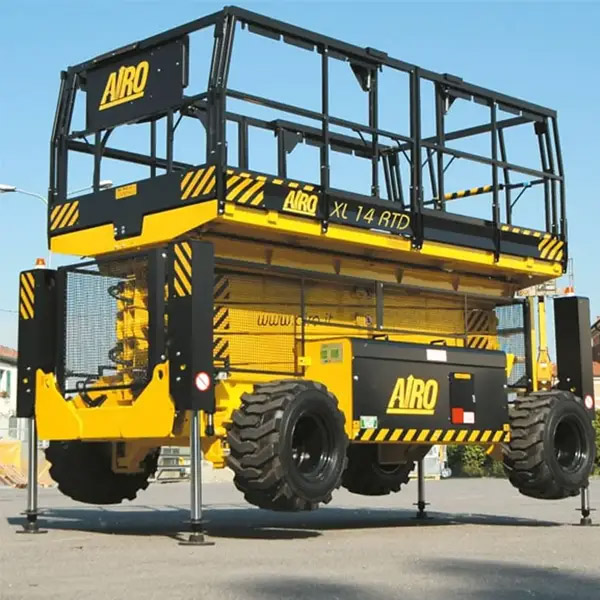
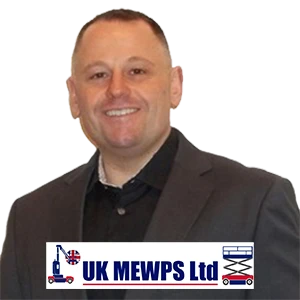
An introduction to Andy Laking, the Author and Editor at UK MEWPS Ltd.
Andy is an equipment rental and hire practitioner with 30 years experience in the UK hire and rental industry. Once leading the largest regional powered access sales force in the UK, he further became the UK’s first Independent Sales Consultant to access rental companies and MEWP OEMs (Original Equipment Manufacturers).
Powered Access Equipment Insights by Andy Laking
My goal with this article is to help MEWPS (Mobile Elevating Work Platforms) end users gain vital insights through useful content, assisting them in selecting the right powered access equipment for their project needs. It’s a complex equipment category, which I’m working to simplify using sector knowledge and shared expertise.
Key Points:
Understanding MEWPs and Their Importance
Mobile Elevating Work Platforms (MEWPs) are essential machines designed to provide temporary access to hard-to-reach areas, typically at height. These platforms are crucial for various industries, including construction, maintenance and warehousing, where safe and efficient access is required. MEWPs, which include equipment like scissor lifts, boom lifts and spider lifts, are integral to modern infrastructure projects, allowing for precision and safety in elevated work. Understanding the different types of MEWPs and their specific applications can help end users choose the best equipment for their needs.
Key Considerations When Selecting Powered Access Equipment
Selecting the right powered access equipment involves considering several key factors. First, assess the height requirement of your project; different MEWPs offer varying working heights to accommodate various tasks. Next, evaluate the weight capacity needed to safely lift personnel and tools. Additionally, consider the nature of the work environment: indoor projects, such as those in hospitals or food production plants, require equipment with specific features like non-marking tyres and compact design. Understanding these factors ensures you select the most suitable powered access equipment for your task.
Meeting Project-Specific Needs with MEWPs
Every project has unique requirements that influence the choice of powered access equipment. For indoor projects, such as electrical installations or interior maintenance, compact and manoeuvrable MEWPs are ideal. Environments that demand minimal disruption, such as hospitals or data centres, benefit from equipment that operates quietly and efficiently. Additionally, projects with space constraints might require compact lifts that offer easy access in tight spaces. By understanding the specific needs and conditions of your project, you can choose the right MEWP that enhances both efficiency and safety.
Andy Laking – Editor & Author at UK MEWPS Ltd
Legal Disclaimer
The information provided in the guides and articles on mewps.uk (the website of UK MEWPS Ltd) is for general informational purposes only. While every effort is made to ensure the accuracy and relevance of the content, UK MEWPS Ltd makes no representations, warranties, or guarantees, express or implied, regarding the completeness, accuracy, reliability, suitability, or availability of the information contained in these guides or on the website for any purpose.
By using this website, you acknowledge and agree that:
1. UK MEWPS Ltd is not responsible for any errors, omissions, or outcomes resulting from the use of this information.
2. The guides and resources provided are not a substitute for professional advice, and you should consult qualified professionals before acting on any information presented.
3. UK MEWPS Ltd disclaims all liability for any loss, damage, or injury caused by reliance on the information provided, including but not limited to incidental or consequential damages.
The use of this website and its resources is at your own risk. For specific advice or guidance related to your individual circumstances, we recommend contacting a professional or qualified expert. For any queries, please contact us at support@mewps.uk.
Read Articles and Guides by UK MEWPS Ltd’s expert author, Andy Laking
Read industry-related content created by Andy Laking. Remember, save the link for updated content…





